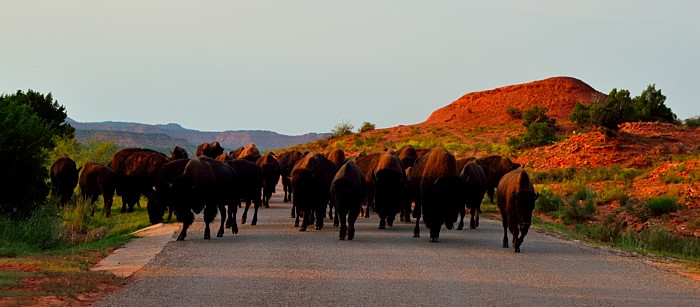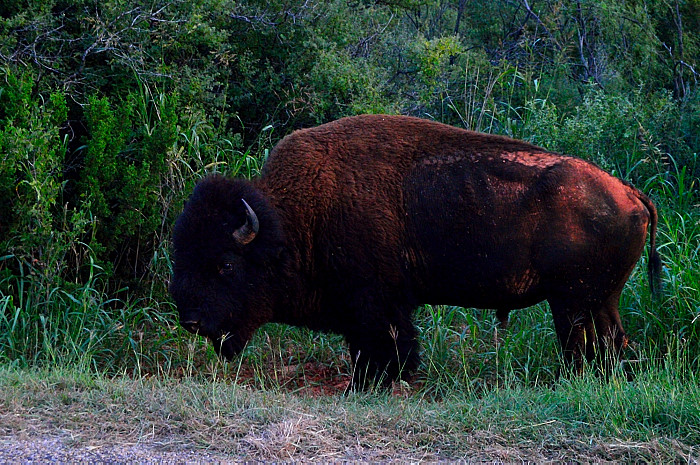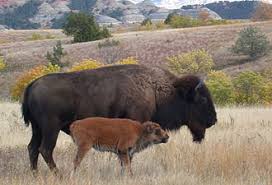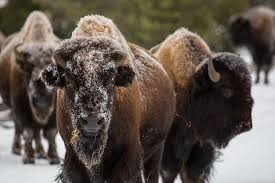Ever wonder what this land was like a century ago? On a recent visit to Caprock Canyons State Park in the Texas panhandle, I got a chance to find out.

Get Out Of My Way!
We headed out at dusk on a solitary paved road through some of our state’s most beautiful, sunset-gilded landscape in search of photo opportunities. I’m riding shotgun, my wife is driving and our dog is curled up in the back seat as we round the bend. There . . . directly ahead . . . is a herd of buffalo, coming our direction, on this very road! We are seriously playing chicken with a horde of North America’s largest land animals! Quickly inundated by a black clot of hump-backed leviathans, we can only marvel. The beasts are indifferent to our presence—natural as beating to a heart—as they make their daily migration to water. We sit there, slack-jawed and awe-struck and realize we have just glimpsed a window into an earlier era. Imagine millions and millions of these noble brutes spread over the Great Plains like some sprawling dark glacier. I now can.
Turns out, this was part of the vast southern plains bison herd that once roamed Texas, Oklahoma and part of Kansas. It’s an elite strain, genetically pure and descended from ancestors dating back to 1878 when legendary rancher Charles Goodnight started the remnants of the herd on his JA Ranch in the Palo Duro area. In fact, this particular herd represents the last remaining example of the southern plains variety of bison in existence. Bison of this herd were introduced into the Yellowstone National Park in 1902 and into the larger zoos and ranches throughout the nation. Most U.S. bison herds have been mixed and moved, but the current herd at Caprock is descended from Goodnight’s original herd and has stayed on its original range.

A Big Bull by The Side of The Road
It didn’t happen by accident. Chalk it up to Goodnight’s wife, Mary. The bison slaughter had wiped out the great Texas herds, and Mary Goodnight, saddened by the killing of the animals, wanted her husband to save a few before they were gone. “He thought bison were interesting, but I think Mary was the passion, the heart and soul, behind the need to save those animals,” says Vicki Sybert, interpretive specialist for TPWD in Lubbock and Goodnight herd historian. The bison were initially donated to Texas Parks and Wildlife Department (TPWD) and moved to Caprock Canyons State Park in 1997. That’s when it was discovered that their DNA was different.
Researchers from Texas A&M University soon discovered that the Texas herd was suffering the effects of inbreeding. In 2003, TPWD brought in bulls from another herd to inject some genetic variability and ensure a more stable future. Because bison are managed in small, geographically separated spaces all throughout the U.S., the problems of inbreeding are solved by managing these herds as a single population. Metapopulation management allows managers to relocate bison between federal, non-federal, and Tribal herds to help increase genetic diversity and viability of the species. Three bison bulls were chosen from a New Mexico herd owned by media mogul Ted Turner, the largest single owner of American bison. Goodnight and Turner — in bison terms—was an almost ideal celebrity marriage.

Prehistoric Bison Were Much Larger
The arrival of bison in America occurred by crossing the ancient land bridge that once connected Asia with North America some 400,000 years ago. These ancient animals were much larger than the bison we know today. Fossil records show that one prehistoric bison, Bison latiforns, had horns measuring 9 feet from tip to tip. In prehistoric times, millions of bison roamed North America—from the forests of Alaska and the grasslands of Mexico to Nevada’s Great Basin and the eastern Appalachian Mountains. Unfortunately, today they are “ecologically extinct” as a wild species, except for a few national parks and other small wildlife areas. At the low point amid the great bison slaughter of the 19th century, only a few hundred animals remained. Today, approximately 500,000 bison live across North America. Most are not pure wild bison.
Okay, time for a little bison trivia. Did you know that President Obama signed the National Bison Legacy Act into law in 2016, officially making the American bison the national mammal of the United States? Bison now join the ranks of the Bald Eagle as the official symbol of our country. As the scientific name makes clear (Bison bison) they are not technically buffalo (true buffalo do exist outside North America) but because people use the names interchangeably, the misnomer is accepted. There are two subspecies: the plains bison (smaller, with a round hump) and the wood bison (larger, with a squarish hump). They live anywhere from 12 to 20 years in the wild, they can reach 11 ½ feet from hooves to hump-top and can tip the scales as much as 2,200 pounds. Despite their mass, they can reach 35 mph on the run; plus, they’re extremely agile. Bison can spin around quickly, jump high fences and are strong swimmers. Takes a little brass to ride a bareback pony into a herd armed with nothing but a sharp stick!

Mama And a Red Dog
So what is life like inside a bison herd? While “herd” is a social construct, there’s a lot of independence too. Females (cows) and adult males (bulls) generally live in small, separate bands and come together in very large herds only during the summer mating season (June through September). Newborn calves are born away from the herd in a secluded area and stay separated until they are old enough to keep up with their mother and the herd. Bison calves are born, orange-red in color, earning them the nickname “red dogs.” After a few months, their hair starts to change to dark brown and their characteristic shoulder hump and horns begin to grow. While bison have poor eyesight, they have excellent senses of smell and hearing. Cows and calves communicate using pig-like grunts, much like Texans eating BBQ.
Like males of most species, bison bulls have plenty of ego. Male bison display their virility by charging and butting heads with other bulls. They also bellow hoarsely, lower their heads, and paw the earth defiantly—they definitely like to put on a show. How can you tell when it’s not just a show? A limp, downward hanging tail is a calm bison; a tail standing straight up is road rage incarnate—get out of the way, he’s about to charge! Normally, bison are gentle giants but being around them in mating season is a risky business. Breeding bulls will protect their chosen females relentlessly and with attitude. With a large harem, so busy are the males with little time to eat, they may lose more than 200 pounds during the breeding season.
Much like domestic cattle, bison are large grazers feeding on prairie grasses, herbs, shrubs and twigs, then regurgitating their food to chew it as a cud before final digestion. Here’s a simple but amazing truth: rabbits eat more than bison! If compared pound for pound, rabbits eat more because they metabolize food quicker. For bison, it takes about 80 hours for grass to pass through their digestive systems, which means they have 80 hours for nutrients to be absorbed. This is why bison can live on lower nutritional quality food.

Take Your Time Big Fella!
So where do most bison hang out? Yellowstone National Park’s herd is estimated at nearly 5,000—making it the largest bison population on public lands. Yellowstone is also the only place in the U.S. where bison have continuously lived since prehistoric times. If you’ve ever visited Yellowstone, you know that bison are free to roam the park at will—much the same as the herd at Caprock Canyons State Park in Texas. It’s not uncommon to see a line of cars stopped for bison crossing the road. When bison travel they form a line and take their sweet time, totally unconcerned about traffic. The winters at Yellowstone can be severe but the bison are built to endure them. Photos of bison facing the north wind, their faces plastered white by snow and sleet, are common fare in park gift shops. As it happens, their shaggy heads are the most insulated parts of their body and they use them to root through the snow to find the vegetation below. Heavy coats are shed in the spring as the animals roll and wallow to loosen the hair, which falls off in gobs.

What’s a Little Snow?
The processes of evolution and extinction have been at work since the beginning of time. There are animals that I dearly would have liked to know—now gone forever. But this was different: this was a case of cranial rectitus. It saddens me to know we did this to ourselves. Thanks to Mary Goodnight, the American bison is still with us. As testament to our shortsightedness, we now protect a remnant—when there once were millions.


